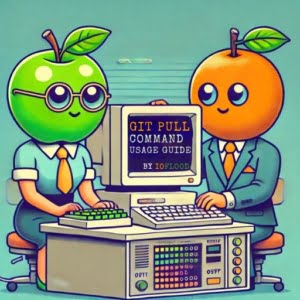Git Pull Command Simplified | What Does Git Pull Do?

While maintaining consistent code across our collaborative scripts at IOFLOOD, we’ve become very familiar with the git pull command. This command helps to fetch and merge changes from the remote repository, ensuring our local code stays current. Pulling from our experiences, today’s article is meant to provide practical tips and examples for our customers looking to start using their bare metal cloud servers for group projects.
Whether you’re new to Git or looking to deepen your understanding, our comprehensive guide will walk you through the functionality, usage, and strategies of the git pull command. By the end of this article, you’ll have everything you need to leverage git pull to its full potential, enhancing your workflow and boosting your productivity.
Let’s dive in!
TL;DR: What is git pull?
git pullis a command in Git that updates your local working branch with the latest changes from a remote repository. It fetches the updates and immediately merges them into your local branch, ensuring your code is always up-to-date. For a simple example, consider the commandgit pull origin master. This fetches and merges updates from the ‘master’ branch of the ‘origin’ remote repository. Read on for more advanced methods, background, tips and tricks.
Table of Contents
Basic Uses with Git Pull Command
Let’s delve deeper into the world of Git by unpacking the git pull command. In Git, git pull is a command that refreshes your current local working branch with the latest updates from its corresponding remote branch.
For example, when you execute:
git pull origin master
Git fetches the content from the specified remote branch and immediately merges it into your current local branch, akin to returning and rechecking a library book to get the updated version.
Essentially, git pull is a fusion of two other Git commands: git fetch and git merge. When you git fetch, Git collects any commits from the target branch that do not exist in your current branch. Subsequently, git merge takes the commits retrieved by git fetch and integrates them into your current branch.
Example of git fetch and git merge vs git pull:
git fetch origin master
git merge origin/master
This is equivalent to:
git pull origin master
The
git pullcommand is a cornerstone in Git-based collaboration workflows, particularly in large-scale projects. It allows multiple developers to work on a project simultaneously without overwriting each other’s changes.
Each time a developer executes a git pull, they are ensuring that their local branch is up-to-date with the project’s latest changes. This synchronization process is vital in maintaining a smooth and efficient workflow, making git pull an indispensable command in any developer’s toolkit.
Explained: What Does Git Pull Do?
Having grasped the basic functionality of git pull, let’s delve into the mechanics of how it works. When you execute the command git pull origin master, two main processes occur. First, Git fetches the changes from the remote master branch that do not exist on your local branch, essentially the git fetch part of the operation. Following this, Git immediately merges these changes into your local branch, the git merge part.
How to Add Remote Repository
Before delving further into utilizing remote repositories, we can’t skip the important step of adding them.
To add a remote repository, use the git remote add command followed by the name you want to give the remote (commonly origin) and the repository URL. Here’s how:
git remote add origin https://github.com/username/repo.git
Let’s break down the command:
– git remote add: The Git command to add a remote repository.
– origin: The name you are giving to the remote repository.
– https://github.com/username/repo.git: The URL of the remote repository you are linking to.
After adding the remote repository, you can verify it using:
git remote -v
This command will show the list of remote repositories linked to your local repository, along with their fetch and push URLs. For instance:
origin https://github.com/username/repo.git (fetch)
origin https://github.com/username/repo.git (push)
Now that you have added the remote repository, you can easily pull updates, push your changes
Discover more customizable methods for managing and adding remote repositories with this thorough guide!
Avoiding Merge Conflicts
Imagine you are working on the master branch of a project and your colleague pushes a commit to the same branch, and you have local changes that you haven’t committed yet.
When you execute a git pull origin master command, Git will try to merge your colleague’s commit with your uncommitted local changes, possibly causing a merge conflict.
git pull origin master
CONFLICT (content): Merge conflict in file.txt
Automatic merge failed; fix conflicts and then commit the result.
To avoid such situations, it’s a good practice to commit any local changes before pulling updates from the remote branch.
If in the case you have already made a commit that creates a conflict it would be helpful to know how to undo a commit with git.
Customized Options in Git Pull Branch
git pull is a versatile command that comes with several options to customize its behavior. Let’s explore some of the most common options and how they can be used to tailor git pull to your specific needs.
The –no-commit Option
One frequently used option is --no-commit. By default, git pull automatically creates a new commit that merges the fetched changes with your local branch.
However, if you use the --no-commit option, git pull will fetch the changes and perform the merge but will not create the commit.
This strategy is different than utilizing a git empty commit, as it gives you the opportunity to review the changes before finalizing the merge with a commit. This can be particularly useful in workflows where transparency and code review are important.
Example of using –no-commit option:
git pull --no-commit origin master
The –rebase Option
Another powerful option is --rebase. When you use git pull --rebase, Git will first ‘stash’ any changes you’ve made on your local branch that haven’t been committed yet. Then, it fetches the changes from the remote branch and applies your stashed changes on top of those.
This results in a cleaner, linear project history without the ‘merge commits’ that are created by a regular git pull.
Since using
--rebasemodifies project history, it can make it harder to follow the sequence of changes if multiple people are working on the same branch. We’ve created a specific article comparing git rebase vs merge, to provide a structured understanding ofgit pull
Generally, it’s recommended to use --rebase only for local branches that aren’t shared with others.
Example of using –rebase option:
git pull --rebase origin master
By strategically using these and other options, you can customize the git pull command to fit your specific workflow and collaboration style.
While --rebase is a useful alternative to a typical git pull, it is also prone to resulting in unforseen conflicts or errors. You can explore various methods to undo git rebase in this advanced guide.
Primary Roles of Git Pull Command
One of the primary roles of the git pull command is to synchronize content between your local and remote repositories. Whenever you execute git pull origin master, Git fetches the latest changes from the remote master branch and merges them into your local branch.
This ensures your local repository is always up-to-date with the most recent changes from your team, maintaining the integrity of your project’s history.
Other Commands for Repository Synchronization
While git pull is an essential command for repository synchronization, it’s not the only one. Two other commands, git fetch and git push, also play crucial roles in this process.
git fetch retrieves changes from a remote repository, but unlike git pull, it doesn’t automatically merge them into your local branch. On the other hand, git push updates the remote repository with your local changes.
Although git fetch and git pull might seem similar, there’s a crucial safety distinction between them. Since git fetch doesn’t automatically merge changes, it’s considered a ‘safe’ command that won’t overwrite your local changes.
This makes it a useful tool for checking what’s new on the remote repository without affecting your local work.
| Command | Description |
|---|---|
| git pull | Fetches changes from remote and merges them into current local branch |
| git fetch | Fetches changes from remote but does not merge them |
| git push | Pushes local changes to remote |
Understanding these Git commands and their implications is vital for maintaining a clean repository state. By using git pull, git fetch, and git push appropriately, you can ensure your team’s work is always synchronized, preventing conflicts and keeping your project history clean and easy to follow.
User Interface for Git Pull Commands
While the command line is a powerful tool for Git operations, it can sometimes be intimidating or cumbersome, especially for beginners.
That’s where the Tower Git client comes in. Tower is a graphical user interface (GUI) for Git that simplifies many Git operations, including git pull.
User-friendly Interface
One of the main advantages of using the Tower Git client is its user-friendly interface. Instead of typing commands into a terminal, you can perform Git operations with the click of a button. This can make Git more accessible, especially for those who are less comfortable with the command line.
Drag-and-Drop Functionality
One of the standout features of the Tower Git client is its drag-and-drop functionality. This allows you to perform complex Git operations, such as branching and merging, by simply dragging and dropping branches in the interface. This can make these operations more intuitive and less error-prone.
Visualizing Git Operations
The client’s visual interface can also enhance your understanding of Git commands, including git pull. By visualizing the operations, Tower can help you better understand what each command does and how they affect your repository.
| Command Line Operation | Tower Git Client Equivalent |
|---|---|
| git pull origin master | Click ‘Pull’ button |
| git push origin master | Click ‘Push’ button |
| git checkout -b new-branch | Drag and drop ‘new-branch’ |
This can be particularly helpful for understanding more complex commands and workflows.
In short, the Tower Git client can make Git operations, including git pull, more accessible and intuitive.
Extensive Resources for Mastering Git
For more information on how to utilize the full potential of Git, here are some additional online resources:
- Official Git Pull Documentation – Detailing options, usage scenarios, and git pull examples.
Simple Guide to Git Pull Remote Branch – Learn to pull updates from remote repositories with examples.
User-Friendly Intro: How to Git Pull – A guide on using
git pullfor updating local repositories.
End: Git Pull Remote Branch to Local
Mastering the git pull command is crucial for effective collaboration and efficient project management in any Git-based project.
Just like returning a library book and checking it out again to get the updated version,
git pullallows you to synchronize your local repository with the content from a remote repository, thereby ensuring that everyone on your team is always working with the most current version of the project.
Throughout this guide, we’ve explored the functionality, usage, and strategies of the git pull command. We’ve delved into its relationship with git fetch and git merge, and we’ve discussed how it plays a key role in Git-based collaboration workflows. We’ve also examined the mechanics of git pull, highlighting the potential issue of unintentional merging and the importance of maintaining your project’s history integrity.
In addition, we’ve looked at several git pull options that can customize the command to your specific needs, including the --no-commit and --rebase options. We’ve also compared git pull with git fetch and git push, emphasizing the importance of using these commands appropriately to maintain a clean repository state.
By understanding and implementing the strategies and best practices we’ve discussed, you can leverage the full potential of git pull to enhance your workflow and boost your productivity in any Git-based project. Remember to use git pull as you would return and recheck a library book to always have the latest version.


